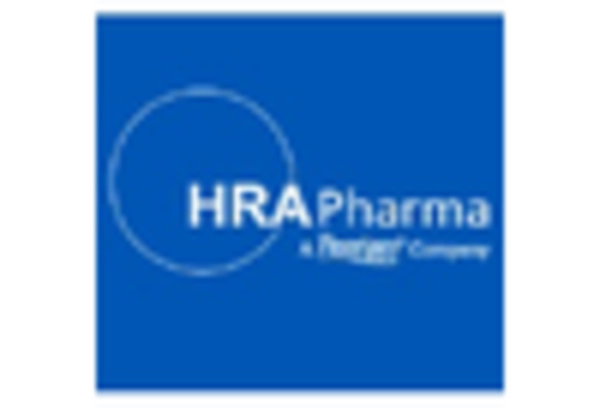The Global Acromegaly Treatment Market was poised for steady growth across various regions. North America held the majority share, valued at 1.24 USD Billion in 2024 and expected to grow to 1.9 USD Billion by 2035, demonstrating its dominance in the market.
Europe followed, with a valuation of 0.84 USD Billion in 2024 and projected to reach 1.3 USD Billion in 2035, signifying a strong presence in the acromegaly treatment landscape. The APAC region was a significant market as well, valued at 0.5 USD Billion in 2024, increasing to 0.75 USD Billion by 2035, reflecting growing awareness and access to treatments.
Meanwhile, South America and MEA represented smaller segments, with valuations of 0.15 USD Billion and 0.11 USD Billion in 2024, respectively, indicating potential for growth due to increasing healthcare investments.
This regional segmentation reflected the varying degrees of market growth, influenced by factors such as healthcare infrastructure, treatment accessibility, and investment in research and development within these regions. The Global Acromegaly Treatment Market data indicated that the increasing prevalence of acromegaly and advancements in treatment modalities are key drivers of this growth trajectory.
Acromegaly Treatment Market Medication Type Insights
A significant part of this market consists of medication options such as Somatostatin Analogs, Growth Hormone Receptor Antagonists, and Dopamine Agonists. Somatostatin Analogs are widely recognized for their efficacy in managing growth hormone excess and are expected to dominate the market due to their established use and safety profile.
In contrast, Growth Hormone Receptor Antagonists represent a newer class of treatments, offering innovative solutions that directly inhibit the action of growth hormone, providing valuable alternatives for patients with resistant cases.
Meanwhile, Dopamine Agonists also play an important role in therapeutic options, particularly for patients who may benefit from lower-cost medications or those seeking initial treatment pathways.
The demand for these medications is driven by a growing awareness of acromegaly and its impacts, thereby fostering a promising landscape for the Global Acromegaly Treatment Market revenue as it evolves to address patient needs effectively.
Acromegaly Treatment Market Route of Administration Insights
The Global Acromegaly Treatment Market is increasingly focused on the Route of Administration, which plays a crucial role in the delivery and effectiveness of treatment options.
The market segmentation highlights various methods such as Injectable, Oral, and Intravenous, each holding distinct importance. Injectable treatments are significant, often preferred due to their direct and rapid biological availability, making them a dominant choice among healthcare professionals.
Meanwhile, Oral administration offers convenience and ease of use, appealing to patients seeking less invasive options. Intravenous administration, traditionally used in hospital settings, remains vital for acute care situations.
The growth is driven by an increasing awareness of the disease and advancements in pharmaceutical formulations that enhance patient adherence and efficacy. However, challenges such as the potential for injection-related complications and the need for specialized healthcare environments for intravenous treatments could impact market dynamics.
Overall, the Global Acromegaly Treatment Market data underscore the importance of diverse routes of administration in meeting patient needs and driving market growth.
Acromegaly Treatment Market End User Insights
The Global Acromegaly Treatment Market is expected to significantly contribute to healthcare settings such as hospitals, specialty clinics, and home care environments.
Hospitals play a vital role in delivering comprehensive care due to their advanced facilities and specialized medical teams, ensuring patients receive timely interventions. Specialty clinics are essential as they focus on acromegaly management, providing tailored therapies and follow-up care aimed specifically at this condition, which enhances patient outcomes.
Home care services have also gained prominence, offering convenience and support for patients who prefer receiving treatment in familiar surroundings, thus improving adherence to therapy regimens.
The combination of these end-user settings highlights the importance of accessibility and personalized care in the management of acromegaly, and this trend is expected to drive market growth as healthcare continues to evolve towards more patient-centric approaches.
As a result, the end-user market segmentation in the Global Acromegaly Treatment Market holds significant potential for advancement and innovation in treatment methodologies, fostering improved quality of life for patients.
Acromegaly Treatment Market Regional Insights
The Global Acromegaly Treatment Market was poised for steady growth across various regions. North America held the majority share, valued at 1.24 USD Billion in 2024 and expected to grow to 1.9 USD Billion by 2035, demonstrating its dominance in the market.
Europe followed, with a valuation of 0.84 USD Billion in 2024 and projected to reach 1.3 USD Billion in 2035, signifying a strong presence in the acromegaly treatment landscape. The APAC region was a significant market as well, valued at 0.5 USD Billion in 2024, increasing to 0.75 USD Billion by 2035, reflecting growing awareness and access to treatments.
Meanwhile, South America and MEA represented smaller segments, with valuations of 0.15 USD Billion and 0.11 USD Billion in 2024, respectively, indicating potential for growth due to increasing healthcare investments.
This regional segmentation reflected the varying degrees of market growth, influenced by factors such as healthcare infrastructure, treatment accessibility, and investment in research and development within these regions. The Global Acromegaly Treatment Market data indicated that the increasing prevalence of acromegaly and advancements in treatment modalities are key drivers of this growth trajectory.


















Leave a Comment